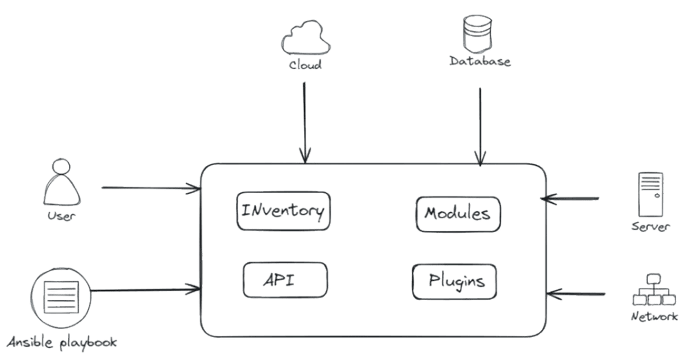
- What is an Ansible Playbook?
- How do Ansible Playbooks Work?
- How to Build an Ansible Playbook?
- How to use Ansible Playbooks?
- What are the Variables of Ansible Playbooks?
- Example of Ansible Playbooks
- Conclusion
What is an Ansible Playbook?
An Ansible playbook is a document wherein customers write Ansible code, a series of scripts that outline the work of a server setup. It outlines a sequence of ranges in a standard IT procedure or a coverage that your distant structures need to follow. Playbooks are collections of one or more performances that can be achieved in a positive order. A play is an ordered series of responsibilities achieved against hosts out of your inventory.The assignment to be achieved is described through performance. Each play has a listing of hosts to configure and duties to complete. There aren’t any standardized performances; every play needs to be written by an administrator. YAML, a human-readable statistics processing language, is utilized in playbooks. YAML is a series acronym for the YAML Isn’t Markup Language. An Ansible playbook simplifies automation by defining tasks to configure systems, such as installing software, managing files, or ensuring specific services are running. With YAML syntax, the playbook is structured for readability and clarity, making it easier for administrators to write and manage. When comparing Ansible and chef , Ansible is agentless and uses YAML for simple automation, whereas Chef relies on a client-server model and Ruby-based DSL, making Ansible more user-friendly for quick deployments. Playbooks help automate repetitive tasks, reduce errors, and maintain consistency across environments. By defining roles and variables, Ansible playbooks enable scalable and reusable automation solutions. Ansible Training equips professionals with the skills to effectively create and manage these playbooks./p>
How do Ansible Playbooks Work?
Ansible modules perform obligations. A play can be created through combining one or greater Ansible jobs. An Ansible Playbook is made of more significant plays. Ansible Playbooks are collections of obligations that run mechanically toward hosts. Your Ansible code stock is made of agencies of hosts.
Each module in an Ansible Playbook is chargeable for a sure undertaking. Each module has metadata that shows the time and in which an activity is performed and which consumer performs it. There are masses of Ansible modules that execute diverse IT obligations, including:
- Cloud management: OCI_VCN creates, deletes, or updates digital cloud networks in Oracle Cloud Infrastructure environments.
- User management: Selogin maps Linux-running system (OS) customers to SELinux customers, and gitlab_user creates, updates, or deletes GitLab customers.
Ready to Earn Your AWS Certificate?View The Microsoft Azure CourseCurrently Provided by ACTE!
- Networking: Dozens of modules cope with utility programming interfaces(APIs), Cisco IOS, NX OS, IOS XR devices, and F5 BIG-IP services.
- Configuration management: PIP manages Python library dependencies even as it consolidates configuration documents from fragments.
- Security: Openssh_cert generates an OpenSSH host or consumer certificate, and ipa_config manages international FreeIPA configuration settings.

How to use Ansible Playbooks?
Ansible uses the YAML syntax. YAML stands for some other markup languages, or YAML ain’t markup language, relying on who you ask (a recursive acronym). YAML document extensions also are varied; however, they are acceptable: (.yaml) or (.yml). Ansible Playbooks may be utilized via the Command Line Interface(CLI) or the Red Hat Ansible Automation Platform’s push-button deployments. To release Ansible Playbooks, use the ansible-playbook command after putting in the open-supply Ansible mission or the Red Hat Ansible Automation Platform. The internet-based consumer interface of the Red Hat Ansible Automation Platform offers push-button Ansible Playbook deployments that can be used as part of larger tasks or job templates. Ansible Training helps users effectively leverage these features for streamlined automation. Ansible Playbooks can automate a wide range of tasks, from configuring servers to deploying applications. The YAML syntax used in playbooks makes it easy to read and write, even for users without a programming background. Through the CLI, administrators can run playbooks to manage infrastructure and ensure consistency across systems. Additionally, the Red Hat Ansible code Automation Platform’s web interface enhances accessibility, offering a user-friendly approach for those unfamiliar with command-line operations. By leveraging the platform’s push-button deployment, users can streamline automation workflows and improve efficiency.
How to Build an Ansible Playbook?
Ansible playbooks have the potential to get quite big and sophisticated. But whether or not you`re writing a quick and candy Building Ansible Playbooks playbook or a big epic, here’s how you do it. Every playbook is split into the subsequent general sections:
- Host: The host segment specifies the computer systems on which the playbook may be executed. This information is derived from the Ansible stock file, so it is a listing of devices.
- Variable: The variable segment is non-obligatory and offers any variables required by the script. It can be as massive or as low as needed.
- Tasks: The undertaking segment describes the use of Modules and identifies the obligations that the goal device needs to perform. Every activity is given a name and a quick description of what it accomplishes, and it is indexed while the playbook is executed.
- Handlers: Handlers are special tasks that are triggered when notified by other tasks. These tasks typically handle actions that need to run only when there’s a change, such as restarting a service after a configuration change.
- Roles: Roles allow for the grouping of tasks, variables, files, templates, and handlers into reusable units. This helps in organizing complex playbooks and can be shared or reused across different playbooks.
- Templates: Templates in Ansible code are used to dynamically generate configuration files using Jinja2 templating. They allow you to create files with variables that get replaced with actual values during playbook execution.
- Conditionals: Allow tasks to be executed only if certain conditions are met, providing flexibility in the playbook. This feature is useful for situations where a task should only run based on the state of the system, the value of variables, or the results of previous tasks also in Azure Cosmos.
- Loops: Enable the execution of a task multiple times with different values. This is especially useful for tasks that need to be performed on a list of items, such as installing multiple packages or creating several files in a loop.
- Defines the name of the playbook, serving as metadata.
- It helps others understand the purpose of the block but does not affect task execution.
- Specifies the group of hosts where the playbook will run.
- Hosts can be defined in an inventory file or directly in the playbook, and they can be grouped into multiple categories.
- Tells Ansible to run the tasks with elevated privileges.
- It is similar to using sudo in a manual session and ensures that tasks requiring higher privileges are executed properly.
- Specifies the user under which the tasks should be executed.
- This can be set to a specific user (like root or sudo) to execute tasks with their permissions.
- Contains the list of tasks to be executed on the hosts.
- Tasks are made up of modules (such as yum, service) that define specific actions.
- Yum: Ensures the installation or update of packages.
- In the example, it installs or updates the http package.
- The state can be adjusted with state: present to install or state: absent to remove it.
- Service: Manages the state of services on the system, such as starting or stopping a service.
- Allow customization of values used within the playbook, such as package names or configuration settings.
- Variables can be defined directly in the playbook, in inventory files, or passed dynamically at runtime.
- Special tasks that are triggered only when notified by another task.
- Handlers are typically used for actions like restarting services or reloading configurations after changes are made. They help ensure smooth updates and can be integrated with AWS Batch automate to manage and execute batch processing jobs efficiently.
- Used to dynamically generate configuration files using Jinja2 templating.
- Templates allow you to create flexible and reusable configurations by substituting variables with actual values during playbook execution.
- Allow tasks to be executed only if certain conditions are met.
- This is useful for making tasks conditional on variables, system states, or results from previous tasks (e.g., running a task only if a file exists or a service is not running).
Eager to Acquire Your Ansible Certification? View The Ansible online Course Offered By ACTE Right Now!
What are the Variables of Ansible Playbooks?
Ansible uses variables to help customers handle device variances, as no structures are the same. Variable names are made of letters, digits, and underscores; however, they need to usually begin with a letter. Variables additionally do not consist of clean spaces. Variables can be described without delay in playbooks using the “vars:” command. Variables may be anything from right nouns to ports to internet servers or even a particular command. For example, you can create a playbook in which you greet people with “How’s it going, eh?” via means of defining a variable called “greeting” with the value “How’s it going, eh?” The message is proven at the terminals when the consumer runs the playbook. Variables are used to keep values; you can construct almost any variable you require. There are variables for businesses and hosts, stock documents, arrays, dictionaries, and unique variables. Special variables are integrated variables that can’t be modified by the consumer and are usually overridden by Ansible code.

You might also preserve variables in a separate document and import them as wished with the vars documents command. It is vital to observe that your playbook no longer ought to include variables if they may no longer be required. They are optional. Variables in Ansible provide flexibility by allowing administrators to customize playbooks without altering the core structure. They enable dynamic configurations, making automation more efficient when managing AWS Services like EC2, S3, and RDS.For example, they can be used to define values that change across environments, such as IP addresses, usernames, or file paths. This helps maintain a single playbook that can be applied to different systems with minimal changes. Additionally, you can pass variables dynamically during playbook execution via the command line or from external files like JSON or YAML. Ansible also supports default values for variables, ensuring that if a variable is not defined, a fallback value is used. Properly managing variables is key to building scalable, reusable, and maintainable automation.
Contemplating a Master’s Degree in Ansible ?Enroll For Advanced Ansible Training Today!
Example of Ansible Playbooks
Name:
Hosts:
Become:
Become_user:
Tasks:
Bracing Yourself for a Ansible Interview? Check Out Our Blog on Ansible Interview Questions & Answer
Modules (Yum & Service):
Variables:
Handlers:
Templates:
Conditionals:
Conclusion
However, since Ansible is a multi-tier orchestration device, it’s easy to combine exams at the realization of a playbook run, both through unfastened duties or roles. When combined with rolling updates, testing procedures can decide whether or not a gadget ought to be returned to a load-balanced pool. Ansible is a powerful, open-supply automation device that simplifies IT operations by permitting configuration management, utility deployment, and orchestration throughout diverse environments. Its agentless structure and human-readable YAML syntax make it accessible for both novices and skilled professionals. With Ansible, businesses can automate repetitive tasks, enhance efficiency, and consistently maintain infrastructure management. Integrating AWS well architected frame work ensures best practices for security, reliability, and operational excellence in automation.It integrates properly with cloud platforms, containerized environments, and conventional IT systems, making it a flexible answer for current DevOps practices. Ansible offers a dependable and scalable automation framework that enhances productivity, reduces manual errors, and streamlines IT workflows. Cloud computing Training helps professionals master automation techniques for efficient infrastructure management.





